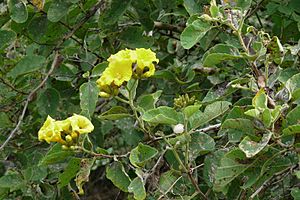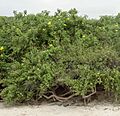Cordia lutea facts for kids
Quick facts for kids Cordia lutea |
|
|---|---|
 |
|
| Growing in Santa Cruz, Galápagos | |
| Scientific classification | |
| Synonyms | |
|
The yellow cordia (scientific name: Cordia lutea) is a beautiful plant. People in Spanish-speaking areas sometimes call it muyuyo. It belongs to the borage family, called Boraginaceae. This plant naturally grows in places like the Galápagos Islands, Ecuador, Peru, and the Marquesas Islands in Polynesia. You can often find it in the dry, low areas of the Galápagos. Its bright yellow flowers are quite big, making it easy to spot!
Contents
About the Yellow Cordia Plant
The yellow cordia can grow as a shrub (a bushy plant) or a small tree. It can reach up to 8 m (26 ft) tall. Its young branches are covered in small hairs.
The leaves of the plant are not divided into smaller parts. They grow one after another along the stem, which is called "alternately arranged." These leaves are usually 4–10 cm (1.6–3.9 in) long. They can be oval or round, with tiny teeth along their edges. The top side of a leaf feels rough but has no hairs. The bottom side, however, is hairy.
The yellow flowers grow in groups called cymes. They have a lovely sweet smell. The petals (the colorful parts of the flower) are joined together. They form a trumpet shape that is 2–4 cm (0.8–1.6 in) wide at the opening. This opening has five to eight small lobes or sections. Inside each flower, there are five to eight stamens (the parts that make pollen).
After the flower is fertilized, a round, white fruit grows. This fruit is called a drupe, and it is about 8–12 millimetres (0.3–0.5 in) across. It usually holds one to four seeds inside. The fruit has a soft, fleshy part. When you first open it, this part feels a bit slimy. But if it touches the air, it becomes sticky.
Plant History and Naming
The yellow cordia was first described by a French botanist named Jean-Baptiste Lamarck in 1791. He noted that it came from Peru. The word lutea in its scientific name means "yellow," often a deep yellow color.
Later, in 1852, a Swedish botanist named Nils Johan Andersson collected plants in the Galápagos Islands. In 1855, he described a plant he called Varronia flava. Today, scientists believe Varronia flava is actually the same species as Cordia lutea.
In places like the Galápagos, where many types of Cordia plants grow, the yellow cordia is easy to spot. Its bright, showy yellow flowers make it stand out!
How Plants Are Related (Phylogeny)
Scientists use a method called molecular phylogenetics to study how plants are related. A study in 2005 looked at the yellow cordia. It suggested that Cordia lutea is most closely related to another plant called C. dentata. Both of these plants come from the "New World" (North and South America).
These two plants are like "sisters" to a large group of species from the "Old World" (Africa, Europe, Asia). Together, they form a group called the Myxa clade. Scientists think this group first appeared in the New World. From there, birds might have carried their seeds to Africa and other parts of the world.
Where the Yellow Cordia Lives
The yellow cordia is native to Ecuador, including both the western mainland and the Galápagos Islands. It also grows in Peru and the Marquesas Islands in Polynesia.
This plant likes to grow in dry areas. In the Galápagos, you can often find it in the lowlands, sometimes very close to the sea.
Images for kids
See also
 In Spanish: Cordia amarilla para niños
In Spanish: Cordia amarilla para niños



